Sri Hanumanji in Gobind Ramayan

Guru Gobind Singh (C. 1675 CE to 1708 CE) was the last (10th) Sikh Guru in human form who terminated the practice of live gurus in Sikhism and declared Guru Granth Sahib as the eternal guru of the Sikh faith. He was the founder of Khalsa Panth and established the norms to be followed by adherents of Sikhism. He was a knower of both Shastra (Scriptures) and Shastra (arms) and recommended the surname “Singh” for followers of Sikhism. He was born at Patna Sahib and spent a long time at Anandpur Sahib near Nayana Mountains close to the banks of the Sutlej River in the Himalayas. At Anandpur Sahib, he completed the composition of Gobind Ramayan.
An article by Srimati Savitri Devi Tripathi entitled “Gobind Ramayan Mey Sri Hanuman” is available in the Hanuman Ank of Kalyan and published by Gita Press, Gorakhpur. The article describes the faith of Guru Gobind Singhji in the Pramatma form of Ram in praise of whom he composed Ramayan in the Punjabi language. Some extracts from Gobind Ramayan have been given by the author of the above-noted article which illustrates Ramayan’s objectives in portraying the characters of Ram and Hanuman. The faith of the composer of Gobind Ramayan in Ram is evident from the following extracts (Punjabi).
“Nrideva Deva Ram Hain, Abheda Dharma Dhaam Hain
Abhuddha Nari Tain Manai, Ashuddha Baat Ko Bhanai
Agaadha Hain, Anant Hain, Abhoot Sobhawant Hain
Kripalu Karma Karanam, Bihal Dyalu Taranam
Aneka Sant Taranam, Adeva Deva Karanam
Suresh Bhaya Rupanam, Samriddha Siddha Bhupanam”
Ram and Hanuman are inseparable. In Gobind Ramayan also the performance of works by Hanuman as detailed in Valmiki Ramayan has been described. However, it is not in such great detail as is found in the Sundarkand of Tulsikrit Ramayan. The role of Hanuman in bringing Sanjeevani Booti from Himalaya for the treatment of Lakshman has been described thus:
“Hagad-Dang Hanua Kagad-Dang Kopa, Bagad-Dang Veeran Mon Paon Ropa
Sagad-Dang Sura, Hagad-Dang Haare, Tagad-Dang Tai Kai Hanu Tau Pukare”
(Hanuman in anger put down his foot on the ground and inquired about the brave who could bring Booti from the Himalayas. When everyone kept mum, Hanuman spoke to Ram.)
“Sagad Sunhu Ragad-Dang Ramam, Dagad-Dang Deejai Pagad-Dang Panam
Pagad-Dang Peetham Thagad-Dang Thoko, Haroun Aaj Panam Suram Mohe Loko”
(Prabhu Ram, please listen, stroke my back and permit me to go. I can bring even God’s nectar today)
The unconsciousness of Lakshman had deeply affected the army of Ram and even Ram seemed broken. The solace provided by Hanuman was encouraging for Ram also. Hanuman reached the Dronachal Parbat but was perplexed to see several herbs there. He decided to uproot the mountain. The Gobind Ramayan describes the progress like this:
“Chagad-Dang Chaunka, Hagad-Dang Hanumanta
Jagad-Dang Jodha, Maha Tejawanta
Ugad-Dang Ukhara, Pagar-Dang Paharam
Agar-Dang Ausadhi, Ko Lai Sidharam
Agad-Dang Aaye, Jahan Ram Khetam
Bagad-Dang Veeram, Jahan Te Achetam
Bagad-Dang Vishlya, Magad-Dang Mukhyam
Dagad-Dang Dari, Sagad-Dang Sukhyam”
The poetic skill in this extract is remarkable in praise of Hanuman. Ramayan has been re-written/translated into various Indian languages. There may be 300 Ramayans. It is a matter of pride that the story of Ram and Hanuman reverberates in various world languages. The story of Ram and Hanuman crossed the seas and reached Southeast Asian countries first and then spread over to far-flung areas with the help of debentured labourers under British rule to far-off places like Mauritius, Fiji and the West Indies. Languages must have changed and stories may have also changed slightly. However, the fundamentals must have remained, more or less, the same.
I am a Vedic astrologer by profession. I have done Jyotish Acharya from Bhartiya Vidya Bhawan. I am devoted to my Sadguru Shri Sai Nath of Shirdi. I am also interested in spirituality. I love to guide people.